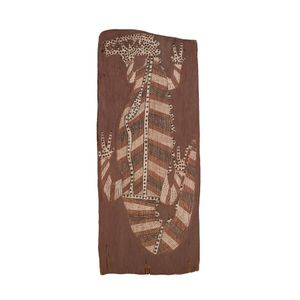Mategot's 'Cinnabar' Tapestry from Aubusson, France
You must be a subscriber, and be logged in to view price and dealer details.
Subscribe Now to view actual auction price for this item
When you subscribe, you have the option of setting the currency in which to display prices to $Au, $US, $NZ or Stg.
- Cinnabar - Cinnabar is an intense deep red colouring agent that has been in use for thousands of years, derived from crystalised red mercuric suphide. It is made into a coating by grinding ore into a fine powder then mixing the powder with lacquer made from the sap of the Rhus tree, which grows in East Asia.
As applied to Oriental antiques, cinnabar refers to successive layers of laquer applied to the metal base of an object. Once the coating has dried and hardened, a further layer is applied. The layers continue to be applied until the thickness is 3 to 6 mm, and this may take up to 200 to 300 coats. At this stage, the surface is ready for the carving, that is characteristic of cinnabar items.
Because of the labour required, cinnabar items are usually small, such as vases, boxes, trays and snuff bottles.
However buyers should be aware that the cinnabar technique has been copied using modern plastic type materials that are moulded rather than carved. A close examination of a genuine cinnabar item under a strong magnifying glass or jewellers loupe should show evidence of the many layers that make up its thickness, and possibly tool marks left by the carver.
This item has been included into following indexes:
Visually similar items

Mick Kubarrku (1925-2008), crocodile (1973), natural earth pigments on eucalyptus bark. 26 x 62 cm

Six panel Chinese lacquer screen, painted to one side with birds and garden to red background with the reverse heavenly landscape scene. Most likely from the Republic period. 2.4m wide, 1.8m high

Lotus Arts de Vivre dragon decorated humidor in cedar wood and masur birch, applied with two sterling silver dragons

A World War I Australian Printed Handkerchief Australian World War I souvenir handkerchief printed on troop ships whilst on way to France as part of the Australian reinforcement contingent, names of the reinforcements are printed on one example and signed
